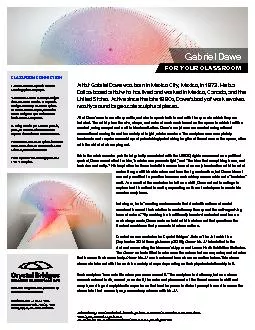

Educator Programs are sponsored by Neff and Scarlett BasoreGabriel Dawe Plexus No 27 2014thread and steel 120 in x132 in x20 ftPhotography by Edward C Robison III CLASSROOM CONNECTION1 Hav ID: 850969
Download Pdf The PPT/PDF document "Artist Gabriel Dawe was born in Mexico C..." is the property of its rightful owner. Permission is granted to download and print the materials on this web site for personal, non-commercial use only, and to display it on your personal computer provided you do not modify the materials and that you retain all copyright notices contained in the materials. By downloading content from our website, you accept the terms of this agreement.
1 Artist Gabriel Dawe was born in Mexico C
Artist Gabriel Dawe was born in Mexico City, Mexico, in 1973. He is a Dallas-based artist who has lived and worked in Mexico, Canada, and the United States. Active since the late 1990s, Dawe’s body of work revolves mostly around large-scale sculptural pieces.All of Dawe’s works are site specific, and aim to speak both to and with the space in which they are installed. The artist plans the size, shape, and color of each work based on the space in which it will be created, using computers to aid in his visualization. Dawe’s sculptures are created using miles of conventional sewing thread in a variety of bright, rainbow colors. The sculptures are completely handmade and require several days of painstakingly stretching lengths of thread across the space, often with the aid of a telescoping rod.While the rainbow color palette is typically associated with the LGBTQ rights movement as a political symbol, Dawe asserts that for him, “a rainbow represents light,” and “the idea that everything is one, and inclusion and unity.” His inspiration for these installations was born of an early fascination with the art of embroidery, a skill his sisters learned from their grandmother, but Dawe himself was not permitted to practice because embroidery was considered a “feminine” craft. As a result of the exclusion he felt as a child, Dawe set out in college to explore traditional textile crafts, expanding on those techniques to create his massive sculptures.In doing so, he is “creating environments that deal with notions of social constructions and their relation to evolutionary theory and the self-organizing force of nature.” By working in a traditionally female-dominated medium on such a large scale, Dawe makes a bold artistic statement that questions the ideals of machismo that permeate Mexican culture.Created as a commission for Crystal Bridges’ State of the Art exhibition (September 2014 through January 2015), Plexus No. 27 is installed in the stairwell connecting the Museum’s Upper and Lower North Exhibition Galleries. The Plexus series is titled to reference the network of nerves, veins, and arteries that traverse the human body. Plexus No. 27 can be viewed from above as well as below. This allows viewers to interact with the work in a variety of ways depending on their physical relationship to it.Each sculpture “comes to life when you move around it.” The sculpture is stationary, but as a viewer moves back and forth, around, or under it, the color and placement of the threads seem to shift and morph, creating a deeply kinetic experience that has the power to distort perception and immerse the viewer into their own unique, personal experience with No. 27 Educator Programs are sponsored by Neff and Scarlett Basore.Gabriel Dawe, Plexus No. 27, 2014,thread and steel, 120 in. x132 in. x20 ft.Photography by Edward C. Robison III. CLASSROOM CONNECTION1. Have students try their hand atcreating spirals on paper.2. Students should use only straightlines to create a series of rhythmicdesigns that may resemble spiralsor other curved shapes, much likethose designed by Gabriel Dawein his Plexus sculptures.3. Using a variety of colored pencils,pens, or markers will add anotherlayer of dimension to students’ work.For more resources on spirals in natureand connections to mathematics andscience, see thelink below.TheHelpfulArtTeacher.blogspot.com/2012/01/spiral. Gabriel Dawe FOR YOUR CLASSROOM 1 smithsonianmag.com/smithsonian-institution/artist-gabriel-dawe-used-60-miles-embroider-thread-make-rainbow2 conduitgallery.com/artists/gabriel-dawe3 news.artnet.com/art-world/bold-thread-installation-takes-over-crystal-bridges-115318